NVIDIA GeForce GTX 780 Overclocking Results
by Ryan Smith on May 28, 2013 10:00 AM EST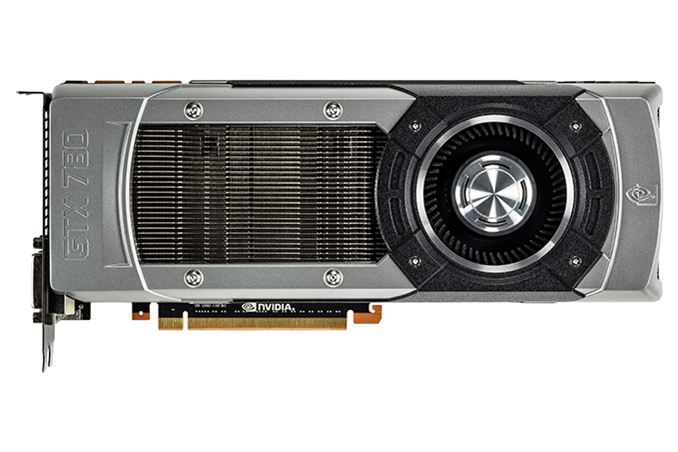
Although we didn’t have enough time to include our GeForce GTX 780 overclocking results in our review of NVIDIA’s latest card, we didn’t want to discard them entirely. Especially not after seeing just how far GTX 780 could overclock. So as an addendum to last week’s review, let’s take a look at GTX 780 overclocking.
When it comes to overclocking, GTX 780 is in an interesting spot. On the one hand it’s already the highest clocked GK110 part, with a base clock of 863MHz, making it the GK110 part closest to any practical clockspeed limits. On the other hand GTX 780 is built against the same power delivery requirements as GTX Titan, with a stock TDP limit of 250W. This is significant because GTX 780 packs a GPU with fewer enabled SMXes than GTX Titan, and perhaps more importantly half as many RAM chips.
So while GTX 780 can’t necessarily clock any higher than GTX Titan, the additional TDP headroom means that it’s more likely to reach its higher boost bins more often, making overclocking more effective. Compounding all of this is the fact that at stock GTX 780 is more often temperature limited than it is TDP limited, amplifying the factor we have the greatest control over (the temperature throttle) and minimizing the factor we have the least control over (the TDP limit).
| GeForce GTX 780 Overclocking | ||||
| Stock | Overclocked | |||
| Core Clock | 863MHz | 1063MHz | ||
| Boost Clock | 902MHz | 1102MHz | ||
| Max Boost Clock | 1006MHz | 1228MHz | ||
| Memory Clock | 6GHz | 7GHz | ||
| Max Voltage | 1.162v | 1.2v | ||
The end result is that while the GTX 780 isn’t going to be an overclocking champion, it’s in a good position to satisfy overclockers. On our sample we’ve been able to push it ahead by 200MHz, moving the base clock from 863MHz to 1063MHz, a 23% improvement. Meanwhile on the memory side NVIDIA’s solid memory controller implementation once more shines through, with our sample easily going from a 6GHz memory clock to a 7GHz memory clock, a 1GHz (17%) improvement.
And what do we get for our efforts? In short, thanks to the fact that GTX Titan is only 11% faster than GTX 780 on average in the first place, GTX 780 can easily exceed Titan’s stock performance when overclocked. Actual scaling depends on the game – not every game scales well with higher clockspeeds alone – but in most games we at least pick up the 17% lower bound that comes with the memory overclock. This means that an overclocked GTX 780 crosses those few 60fps thresholds that the stock GTX 780 fell just shy of, including the minimum framerate in HItman: Absolution, and the average framerate in Crysis 3.
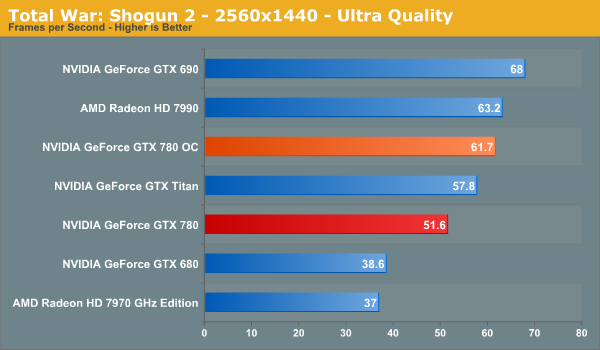
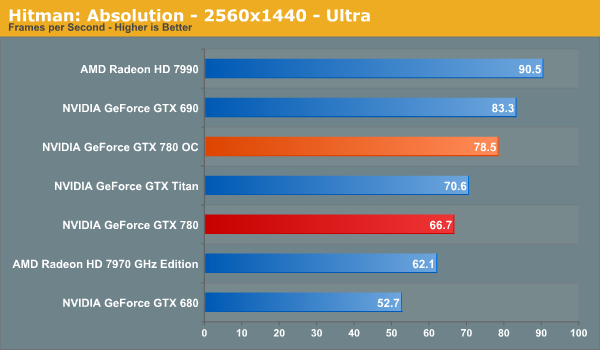

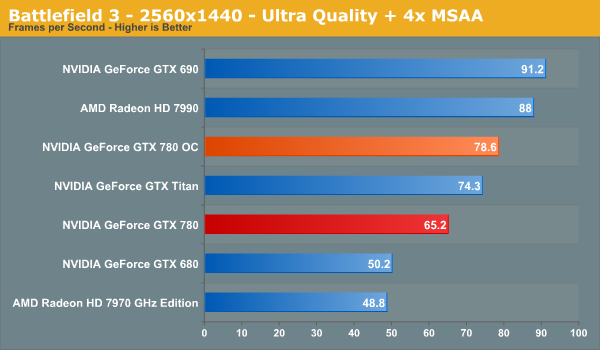

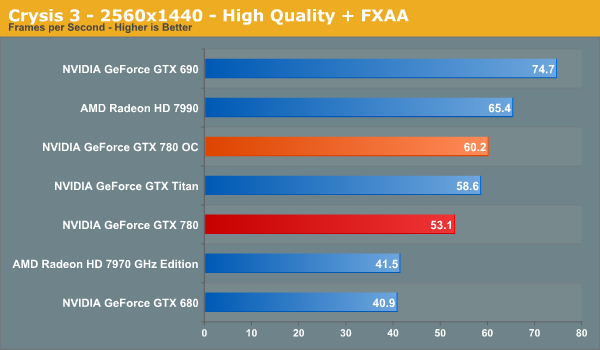
One of the more pronounced outcomes of overclocking the GTX 780 is that we’re essentially exchanging the card’s temperature limit for its TDP limit. Being temperature limited keeps fan speeds down and reduces leakage, but it’s also a limit we have a great deal of control over. Whereas with the TDP limit we can only raise it by 6%, from 250W to 265W, which is immediately consumed by a combination of higher boost bins, higher again boost bins from overvolting, and slightly increased leakage. The end result is that the TDP limit places a rather hard cap on performance, although the ultimate performance limit remains untouched since we can’t completely discard power for performance, leaving the highest boost bins underutilized.
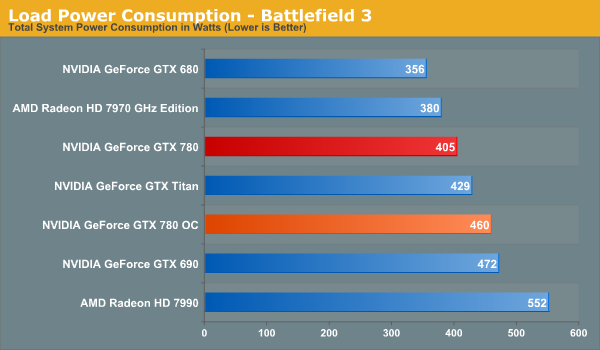
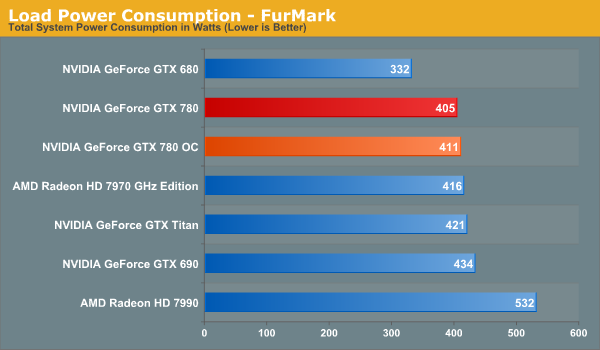
Because GTX 780 is more often temperature limited, and hence running under its TDP, overclocking does come with some pretty stiff consequences for power consumption. Power consumption under FurMark only rises by 6W at the wall since it’s already TDP limited, but in BF3 the difference is 55W at the wall. Some of that is due to higher CPU power consumption as the CPU is tasked with generating more frames, but most of that is from GTX 780 itself. As we saw earlier the performance increase is quite good, but accessing it does mean giving up the GTX 780’s finely honed performance/power ratio.
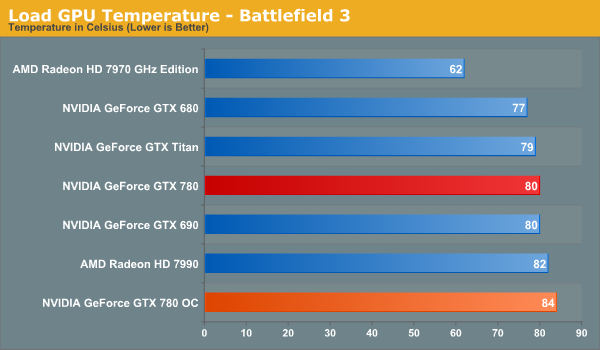
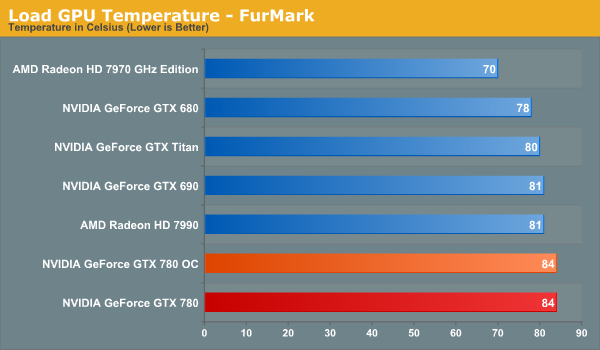
As for load temperatures, these top out at 84C. The temperature throttle itself stands at 95C, but between TDP throttling and the fan curve, the default programming of the GTX 780 keeps it at 84C in this case.

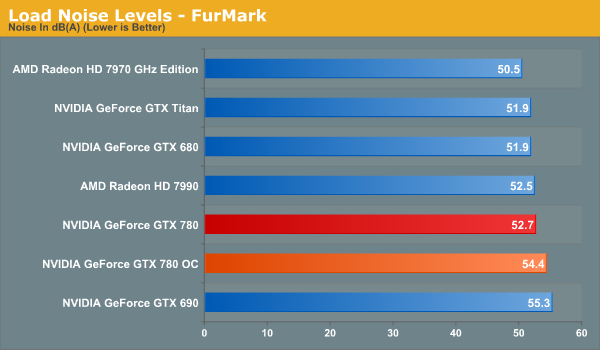
Finally, as to be expected from our power numbers, the noise cost of overclocking is equally expensive. The change under FurMark is under 2dB, but with BF3 the noise increase is over 6dB, from 48.1dB to 54.4dB. Note that this is with the GTX 780’s default fan curve, and moving the curve would allow us to reduce fan noise in exchange for higher temperatures. But at the same time the leakage effect would reduce performance a bit (we’re already TDP limited) and we’d be pushing GTX 780 to the high 80s or higher.
Wrapping things up, when it comes to overclocking the GTX 780 we’re looking at a 17% average performance improvement for a 55W increase in at-the-wall power consumption and 6.3dB increase in noise. This is enough to not only equalize GTX 780 and GTX Titan, but is enough to push GTX 780 ahead by 6% in all of our benchmarks at 2560. Whether it’s worth it is ultimately an individual decision, but in general this is a fairly reasonable tradeoff, especially if the additional noise isn’t a great concern.










39 Comments
View All Comments
Daggarhawk - Wednesday, May 29, 2013 - link
I've attempted to quantify price/performance. Let's assume $1000 ea for the top three cards, $650 for the 780 and $450 for the 7970GHz. Averaging the FPS results of all five games, you get the below. Assuming "100%" for the Titan, you get very good results for the 780 relative to its class. However, we're not seeing good results relative to top shelf "current gen" single gpu cards. "Next Gen" to me ought to mean far and away surpassing the "previous gen" in price performance. By that standard what we're seeing is simply pay more get more, which is fine for what it is, but we didn't necessarily need a new card for that. A bit lame from Nvidia. Hopefully AMD can demonstrate the meaning of next generation.Card Performance/Price relative to Titan
GTX 690 120%
Radeon HD 7990 118%
GTX Titan 100%
GTX 780 OC 163%
GTX 780 139%
GTX HD 7970 GHz 159%
-----------------
Card Ave AnandTech FPS
GTX 690 79.16
Radeon HD 7990 78.1
GTX Titan 65.98
GTX 780 OC 70.08
GTX 780 59.7
GTX HD 7970 GHz 47.24
maximumGPU - Thursday, May 30, 2013 - link
Well put. Had they been more aggressive with pricing they would've had a card worth calling "next gen". the price/performance of this card only confirms we've done zero progress since last year.Daggarhawk - Thursday, May 30, 2013 - link
Spoke too soon. The 770 pricing is excellent, and easily makes obsolete the 680 and 670 in the retail space.Laststop311 - Thursday, May 30, 2013 - link
Well it was awesome blowing 1050 on a titan which nvidia promised would not be passed in performance by the next generation. Yes depending on your definition of performance the gtx 780 doesn't pass it but man I would of much rather paid 650 and just did a slight overclock to not jack the noise up too bad and I would have practically even gaming for 400 less. Oh well that's how the cookie crumbles in the PC world.maximumGPU - Thursday, May 30, 2013 - link
if you're only interested in gaming, then why where you ok paying the premium for all that compute performance in Titan? Titan should be bought only by those interested in compute or both compute/gaming.for gaming only it's ridiculously poor value.
Daggarhawk - Thursday, May 30, 2013 - link
don't rub it in maximumGPU. let's be honest, Nvidia aggressively and almost exclusively marketed the Titan as a gaming component. And it was impressive that k|ng|p|n was able to blow away the previous 3dmark scores under LN2 with Titans on air. Quad Titans will still be the most powerful gaming machine possible, but.... well... it also happens to redefine overkill and be within financial reach of only a handful of bourgeois enthusiasts.djnforce9 - Thursday, May 30, 2013 - link
The settings in this article did not work for me but I managed to find something just under that worked along with a voltage of +25mV. Sometimes running the so called stress tests (e.g. FurMark, heaven, etc) is deceiving. The card could remain stable for long periods of time but then when you go to load up a game, THEN it crashes. In my case, the article's settings didn't play nicely with "Sacred 2 - Fallen Angel" (crashed within seconds on the menu screen with the "Display stopped responding" error). Lowered the clock settings and it worked great again.nleksan - Saturday, June 1, 2013 - link
Pretty impressed with the 780 so far, although it's hard to get excited when we get two new cards, one of which is $1000 and the other $650+, while the rest of the lineup is barely even a refresh of what we already have available...I'm pretty sure I'm just going to go 3-way SLI with my GTX670 FTW's, as they're overclocking BEASTS (running both @ 1432core/1843(7372effective)memory), and just throw in a 650Ti/Boost/550Ti for PhysX and some extra Compute power... Already placing higher than most 680's/7970's on HWBot in single and dual-card benches, and games run SMOOTHLY (had 2x 7970 Lightning's but I would have gotten rid of them even if they hadn't been killed by EK water blocks...)... I don't even use my 680 Lightning's for anything other than benching anymore, really...
HOWEVER... If they introduce a GTX 780 Lightning 3GB or ideally 6GB card, with further beefed-up power delivery AND MOST IMPORTANTLY fully-unlocked voltage control, AND if Aquacomputer and/or Watercool/Heatkiller blocks become available for it, I will strongly consider buying a pair...
In my experience with the Lightning's, which is every model since they were introduced, if done properly we could see ~1400core and ~7500mem out of these cards with nothing but regular water cooling, ~1475-1550core and ~7800mem with chilled water, and who knows how high with sub-zero cooling!!!
Iskaa1990 - Monday, June 3, 2013 - link
Quick question: Why are the Anand FPS Scores for Games so much higher compared to any other sites?